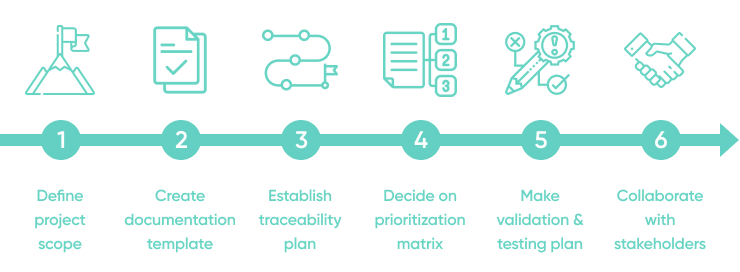Requirements management planning is essential to the success of any software project. According to a recent survey, 70% of IT project failures are due to inadequate requirements, resulting in an average cost overrun of 27%.
A well-defined requirements management plan can help prevent these problems, ensuring that all requirements are properly tracked, documented, and implemented.
In this article, we'll show you how to create a requirements management plan, step-by-step. We'll also provide a requirements management plan example to help you get started.
- What is requirements management planning?
- What is the purpose of a requirements management plan?
- What are the key elements of a requirements management plan?
- How to create a successful requirements management plan
- Common questions about the requirements management process
- Requirements management plan example (Google Doc)
- Conclusion
What is requirements management planning?
Requirements management planning is the process of capturing, tracking, analyzing, and verifying all requirements for a given project. It’s not merely planning but also overseeing the implementation of project requirements through the development and testing phases. It is a critical component of successful project management and helps ensure that the project delivers the desired results.

What is the purpose of a requirements management plan?
At its core, a requirements management plan provides a means for a project manager to manage the process of collecting, documenting, prioritizing, amending, and validating detailed product requirements to ensure the product is delivered in correspondence with business and technical expectations.
More specifically, the purpose of requirements management planning is to ensure that:
- All project deliverables are documented as formal requirements
- All business and stakeholder requirements are gathered and documented
- All of the project stakeholders are aware of the project scope
- Requirements are prioritized in a standard way
- Requirements can be verified systematically
- The project manager has a plan to manage requirements and meet project objectives
What are the key elements of a requirements management plan?
A requirements management process is ongoing, beginning when the software project scope is being defined and ending when all project requirements have been verified and the product has been successfully delivered. Throughout this process, the project manager will utilize a requirements management plan document to help manage the requirements.
The scope of the document will depend on the specific project at hand, but in general, a requirement management plan should include:
- Project overview: Outlines the purpose of the software project, the desired outcome, and any specific goals and objectives to be achieved.
- Scope: Often defined in separate Software Requirements Specification, describes the scope of the software project, including the duration of the project, the type of software being developed, and the project budget.
- Roles & responsibilities: Lists all project team members, including who the project stakeholders are, who will provide input for defining the project’s requirements, and who the levels of management are.
- Prioritization categories: Describe the priority levels that can be assigned to requirements and who will make the final decisions about the requirements’ priorities.
- Categories: Detail out the various categories of requirements such as functional, non-functional, maintenance, support, etc.
- Requirements analysis plan: Explains the process of analyzing and validating the software requirements, including an overview of the techniques, tools and methods to be used.
- Requirements traceability plan: Describes the process of tracking and tracing changes to requirements, including the review and approval process and version control.
- Testing and validation plan: Explains the process of testing the software requirements, including the use of test cases and specifications.
- Reporting plan: Describes the process of reporting on the progress of the software project, including the use of metrics, KPIs, and other reporting tools.
How to create a successful requirements management plan

Creating a requirements management plan from the ground up can be overwhelming. To help you get started, we’ll cover 6 basic steps that are designed to help you put together the requirements plan and set you up for successful project management through the life of the project.
Define initial project scope
Before doing anything else, you should have a clearly defined project scope. Without this, you’ll have no single source of truth that can drive the requirements for your project. Typically the project manager will define the project scope in a separate scope management plan or your requirements management plan may simply have a small section that defines the project scope.
Either way, you should consider the following questions to ensure you have a project scope that is sufficiently defined before you move forward:
- What is the desired outcome of the project?
- What are the needs of each stakeholder? Are there any conflicts that need to be resolved?
- Who are the project sponsors and what is their understanding of the project scope?
- What is specifically not in scope?
- What is the project timeline and budget?
- Are there any specific technologies that will be used or should not be used?
- What resources are available for this project?
Create a documentation template
With a project scope defined, it’s time to get requirements management tools in place to help with your requirements management efforts. One of the main tools you will use is a spreadsheet that documents every requirement.
Creating this type of document is a simple process. Start by creating a spreadsheet that looks something like this:
RequirementNumber | Requirement Name | Requirement Description | Priority | Developer Assigned | Status |
- Requirement number: Unique numerical identifier.
- Requirement name: A brief description of the requirement.
- Requirement description: More details to provide context for the requirement.
- Priority: Used to rank the importance of the requirement. The project manager should prioritize requirements based on the prioritization matrix defined in Step 4 below.
- Developer assigned: Name of the person assigned to implement the requirement.
- Status: Indication of whether the requirement has been completed.
At this stage you do not need to fill in the tracker. Simply create the document itself and run it past your colleagues, project stakeholders, or management to get input before it goes into practice.
Establish a plan for traceability
Part of requirements management is establishing traceability. In other words, establishing configuration management processes for tracing where every requirement came from along with any changes to the requirements throughout the course of the project.
This is very important as what can often happen is teams get to the end of a project, they test against every requirement and then call the project “done.” But, unfortunately, along the way, requirements were changed or removed altogether and one or more of the project stakeholders did not agree to this change.
As you build a plan for traceability, consider these questions:
- How will changes to project deliverables be managed? How will these changes be documented and who needs to approve them before corresponding requirements are updated?
- How will changes to the project’s requirements be managed? How will these changes be documented and who needs to approve them? Who will communicate requirement changes to the development team?
- How will you establish traceability as part of your requirements management plan? Will it pass an audit?
- How will the source or owner of each requirement be documented? Who is allowed to request new requirements be added?
Decide on a prioritization matrix
Next up as part of the requirements management process, you need to decide on a matrix for prioritizing the project requirements. A prioritization matrix is a tool used to organize software requirements and prioritize them according to their importance. This matrix should:
- Identify who has the power to request or decide on requirement priorities.
- Establish a standard set of priorities such as: “must have”, “should have” and “nice to have” or priorities 1-10.
- Define the criteria for each priority label. In other words, what justifies a requirement being ��“1” vs “10” or “nice to have” vs “must have”?
When deciding on a prioritization matrix for software requirements, it is important to consider the overall objectives of the project, the timeline and budget, and any already-established internal practices at your organization.
Make a validation and testing plan
As the project progresses and software requirements begin to be implemented, it will become necessary to validate and test each one to ensure that the requirement has been met by the software. Every requirements management plan should specifically define the general process for validating and testing requirements as well as define the specific test cases for each requirement. It should include:
- Set of positive test cases for each requirement that verifies that the requirement is met.
- Set of negative test cases for each requirement that establishes a point of failure for each requirement.
- Plan for executing the tests, including testing software needed, staffing resources, and a timeline for test execution.
- Documentation requirements for any issues found.
Collaborate with stakeholders
Collaboration is key at all stages of the requirements management planning process. Project stakeholders need to be actively involved in the process and ensure that their perspectives and requirements are fully understood. Collaboration with stakeholders could look something like:
- Requesting input on requirement definition through one-on-one discussions, focus groups, or surveys.
- Aligning the project’s scope, goals, and objectives with other internal initiatives, ensuring development projects are not in conflict.
- Sharing prioritization matrix or traceability matrix information with all project stakeholders.
- Sharing change management, requirements approval, or testing processes with all stakeholders.
- Asking stakeholders to participate in the final review process before requirements are verified and approved.

Common questions about the requirements management process
The requirements management process can be complex. Establishing documentation practices, managing the project’s stakeholders, handling conflicting requirements throughout the project… it’s not an easy task.
To help alleviate some of the stress, let’s answer a few of the top questions that project managers have about this process:
What type of requirements should be documented by the project manager?
Generally, requirements break down into one of two categories:
- Functional requirements: Describes the features and functions the software should provide, and how the user will interact with them.
- Non-functional requirements: Describes the requirements for a system or product that do not directly affect the behavior or functions of the product, but instead describe its qualities or characteristics. This could include availability, usability, security, industry standards, support, maintenance, and scalability.
How should changes to project scope and requirements be managed?
Changes to the project scope will trigger corresponding changes to the project requirements. This can also happen the other way around, where changes to requirements will inherently change the scope (or even cause scope creep).
In either case, the project manager should utilize one or more of the following strategies to handle the changes:
- Establish a change control board (CCB) to review and approve scope and requirement changes. The board should include representatives from all project groups, such as the development team, product management, quality assurance, and operations.
- Create a change request process that outlines who can request changes, how to request them, and how they will be evaluated and approved.
- Document all changes to the scope and requirements in the project’s change log.
- Follow up on changes and monitor their progress to ensure the project is still on track and the scope remains manageable.
- Communicate changes to all stakeholders, including the development team, end users, project management team.
How can a requirements management plan reduce project risk?
A requirements management plan helps to reduce project risk by:
- Providing a consistent and structured approach for managing requirements as part of a broader project management process.
- Ensuring that all stakeholders are on the same page about the project's goals and objectives.
- Avoiding any misunderstandings or miscommunication that could lead to project delays or even project failure.
- Providing a framework for tracking progress and ensuring that the project is meeting its objectives.
What’s the difference between a scope management plan and a requirements management plan?
A scope management plan outlines the scope of a project and defines the boundaries of what is included and not included in the project. It is used to ensure that all stakeholders understand the scope of the project and the deliverables.
A requirements management plan defines how requirements are collected, analyzed, documented, tracked, and managed throughout the life cycle of a project. It also defines how requirements are prioritized, how changes to requirements are managed, and how conflicts between requirements are addressed.
A scope management plan and a requirements management plan are typically both part of a larger or more comprehensive project management plan.
Requirements management plan example (Google Doc)
Ready to start your own requirements management planning? Get a copy of the example requirements management plan template!
Conclusion
Creating a comprehensive requirements management plan is essential for any software project. It helps to ensure that all requirements are properly tracked, documented, and implemented, while reducing project risk and avoiding project delays.
By following the steps outlined in this article, you can create a successful requirements management plan that will help you deliver a product that meets business objectives and delivers real value to your organization.







